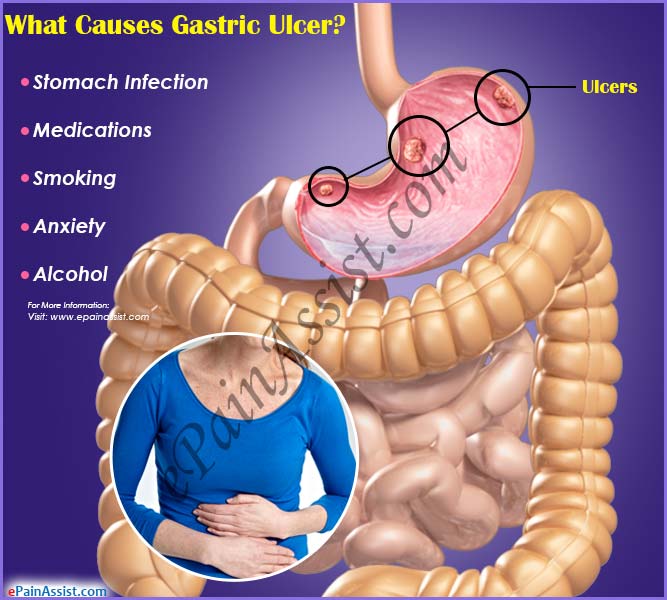The gastrointestinal system is formed by stomach, small intestine, large intestine, sigmoid colon and anus. Stomach, small intestine and large intestine lies in abdomen, while sigmoid colon and anus lies in pelvis or pelvic cavity. Stomach is connected to esophagus at upper or proximal end and duodenum at distal end. Small intestine is divided in 3 section duodenum, jejunum and distal small intestine. Duodenum continues as jejunum, similarly jejunum continues as a distal small intestine. Large intestine is larger in diameter than small intestine and continues as a sigmoid colon within pelvis.
The ulcer located within mucosal membrane of stomach is also known as gastric ulcer. Similarly, ulcer localized in duodenum is known as duodenal ulcer. The peptic ulcer is a common diagnosis used to describe ulcer localized within stomach and/or duodenum.
The gastric ulcer is either superficial or deep erosion of stomach mucosal membrane. The superficial gastric ulcer mostly causes burning pain, while deep rooted ulcer causes pain as well as erosion of tiny blood vessels that are embedded in mucosa resulting in bleeding within gastric or stomach cavity. The symptoms of deep ulcer are burning pain, hematemesis and Melena. When patient starts spitting or vomiting blood, the symptom is known as hematemesis and Melena is a condition when stool turns black because of blood in stool.

What Causes Gastric Ulcer?
Gastric Ulcer Caused Due to Gastric or Stomach Infection- The bacterial infection of stomach mucosa caused by Helicobactor pylori causes severe inflammation of mucosa, which results in single or multiple gastric ulcer.
Medications That Can Cause Gastric Ulcer-
- NSAIDs- Long term use of NSAIDS like aspirin, Motrin or naproxen causes erosion of stomach mucosa, which results in gastric ulcer.
- Corticosteroids- Long term use of corticosteroids damages mucosal membrane and causes gastric ulcer.
Smoking- Long term frequent smoking increases gastric acid secretion. Acidic gastric juice eventually cause damage to superficial layer of stomach mucosa, which results in gastric ulcer.
Anxiety- Frequent and prolonged anxiety causes increased gastric acid secretion, which follows development of mucosal superficial erosion results in gastric ulcer.
Alcohol- Frequent and daily consumption of alcohol causes gastric ulcer formation because alcohol causes mucosal damage.
What are the Symptoms of Gastric Ulcer?
Pain- Pain is felt on left side in front of abdomen below the rib cage. Pain is severe on an empty stomach. Pain is felt dull, mild and continuous after food intake in most individual suffering with gastric ulcers. Character of pain is burning pain. Pain is the most common single symptoms observed if patient is suffering from gastric ulcer. Severe penetrating pain is often felt when stomach is empty. The severe pain is caused by acidic gastric secretion observed in higher volume before lunch or dinner. The gastric secretion becomes acidic when not diluted by food. Thus volume of low pH gastric juice is higher when stomach is empty and pain felt is severe as well as stabbing or penetrating in nature. Such pain is observed before breakfast, lunch or dinner. Patient feels better after consumption of food.
Weight Loss- Symptoms of weight loss is observed in patient suffering with prolonged gastric ulcer. The cause of weight loss is low food intake caused due to continuous stomach pain as well as anxiety and loss of appetite.
Acid Reflux- Anxiety, smoking and frequent consumption of alcohol causes increased stomach secretion. The normal pH of stomach or gastric secretion is acidic. The acidic pH also delayed the gastric emptying time. The stomach gastric juice stays in stomach for longer time and eventually results in regurgitation. Regurgitation or belching causes frequent acidic juices returning in oral cavity. In few cases the smaller quantity regurgitation is not recognized until patient is simultaneously suffering with esophageal ulcer and pain.
Hemoptysis- The prolonged standing deep ulcer causes erosion of mucosa and bleeding. The ulcer and pain often delays gastric emptying time. The retained stomach contained with blood in few cases regurgitate in mouth and spitted out. The symptoms is known as hemoptysis.
Melena- It is the symptom observed in few cases when occult blood is observed in stool.
How is Gastric Ulcer Diagnosed?
Barium Enema- Barium enema is a radiological study. Barium is radio opaque. The bulk of barium is ingested as a barium meal. The barium spreads along the mucosa of stomach. After 1 hour of ingestion of barium multiple images of stomach is taken and studied. The breech in mucosal lining suggests presence of gastric ulcer.
Endoscopy Study- Endoscope is a tubular and linear camera. The cylindrical long camera passed through mouth into stomach. The physician observes the gastric mucosa through eye piece, which lies on opposite end. In most cases physician is able to see the ulcer and take pictures. Endoscopic study of stomach is known as gastroscopy. Gastroscopy is reliable study to diagnose gastric ulcer.
Also Read:
